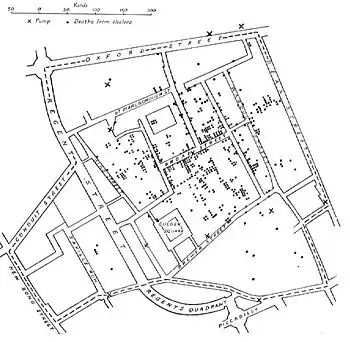Outbreak response
Outbreak response or outbreak control measures are acts which attempt to minimize the spread of or effects of a disease outbreak. Outbreak response includes aspects of general disease control such as maintaining adequate hygiene, but may also include responses that extend beyond traditional healthcare settings and are unique to an outbreak, such as physical distancing, contact tracing, mapping of disease clusters, or quarantine. Some measures such as isolation are also useful in preventing an outbreak from occurring in the first place.
| Outbreak response | |
|---|---|
 John Snow was the first to map clusters of cholera during the 1854 Broad Street cholera outbreak in London. This even is widely considered the birth of modern epidemiology and lead to appropriate sanitary measures which put a stop to the outbreak. | |
| Other names | Epidemic response, epidemic control, pandemic response |
| Specialty | Public health, epidemiology, disease controlClinical epidemiology, infectious diseases |
Epidemic response or pandemic response is when outbreak response are used within a disease outbreak that has been classified as an epidemic or pandemic.
Outbreak response is normally conducted by teams, which include infection control physicians, epidemiologists, infectious disease specialists and a number of other specialties. Mathematics and mathematicians are often involved in constructing models of disease spread.
Strategies
The basic strategies in the control of an outbreak are containment and mitigation. Containment may be undertaken in the early stages of the outbreak, including contact tracing and isolating infected individuals to stop the disease from being spread to the rest of the population, other public health interventions on infection control, and therapeutic countermeasures such as vaccinations which may be effective if available.[3] When it becomes apparent that it is no longer possible to contain the spread of the disease, it will then move on to the mitigation stage, when measures are taken to slow the spread of disease and mitigate its effects on the health care system and society. In reality, a combination of both containment and mitigation measures may be undertaken at the same time to control an outbreak.[4]
A key part of managing an infectious disease outbreak is trying to decrease the epidemic peak, known as flattening the epidemic curve.[1] This helps decrease the risk of health services being overwhelmed and providing more time for a vaccine and treatment to be developed.[1] Non-pharmaceutical interventions may be taken to manage the outbreak; for example in a flu pandemic, these actions may include personal preventive measures such as hand hygiene, wearing face-masks and self-quarantine; community measures aimed at social distancing such as closing schools and cancelling mass gathering events; community engagement to encourage acceptance and participation in such interventions; as well as environmental measures such as cleaning of surfaces.[2]
Another strategy, suppression, requires more extreme long-term non-pharmaceutical interventions so as to reverse the pandemic by reducing the basic reproduction number to less than 1. The suppression strategy, which include stringent population-wide social distancing, home isolation of cases and household quarantine, was undertaken by China during the COVID-19 pandemic where entire cities were placed under lockdown, but such strategy carries with it considerable social and economic costs.[5]
References
- Anderson RM, Heesterbeek H, Klinkenberg D, Hollingsworth TD (March 2020). "How will country-based mitigation measures influence the course of the COVID-19 epidemic?". The Lancet. 395 (10228): 931–934. doi:10.1016/S0140-6736(20)30567-5. PMC 7158572. PMID 32164834.
A key issue for epidemiologists is helping policy makers decide the main objectives of mitigation—eg, minimising morbidity and associated mortality, avoiding an epidemic peak that overwhelms health-care services, keeping the effects on the economy within manageable levels, and flattening the epidemic curve to wait for vaccine development and manufacture on scale and antiviral drug therapies.
- "Community Mitigation Guidelines to Prevent Pandemic Influenza – United States, 2017". Recommendations and Reports. Centers for Disease Control and Prevention. 66 (1). 12 April 2017.
- "3. Strategies for Disease Containment". Ethical and Legal Considerations in Mitigating Pandemic Disease: Workshop Summary. National Academies Press (US). 2007.
- Baird, Robert P. (11 March 2020). "What It Means to Contain and Mitigate the Coronavirus". The New Yorker.
- "Impact of non-pharmaceutical interventions (NPIs) to reduce COVID19 mortality and healthcare demand" (PDF). COVID-19 Response Team. Imperial College. 16 March 2020.
Sources
- "ECDC activities on epidemic intelligence and outbreak response". European Centre for Disease Prevention and Control. Retrieved 2020-03-26.
- "Outbreak Response". The Task Force for Global Health. Retrieved 2020-03-26.
- Division of Foodborne, Waterborne, and Environmental Diseases (DFWED) (2019-02-20). "Outbreak Response Enteric Illnesses | | Foodborne, Waterborne and Environmental Diseases". National Center for Emerging and Zoonotic Infectious Diseases (NCEZID). Centers for Disease Control and Prevention (CDC). Retrieved 2020-03-26.
{{cite web}}: CS1 maint: multiple names: authors list (link) - PREPARE EU. "Outbreak response modes". www.prepare-europe.eu. Retrieved 2020-03-26.
- National Institute for Communicable Diseases (NICD). "Outbreak Response". Retrieved 2020-03-26.
- https://odh.ohio.gov/wps/portal/gov/odh/know-our-programs/outbreak-response-bioterrorism-investigation-team
- Policy, Board on Health Sciences; Medicine, Institute of; National Academies of Sciences, Engineering (2016-05-06). Strengthening Outbreak Management and Emergency Response Systems. National Academies Press (US).
{{cite book}}:|last1=has generic name (help) - SHEA Expert Guidance. "SHEA Guidance and Resources for Healthcare Epidemiologists in United States Acute-Care Hospitals". Outbreak Response and Incident Management. Society for Healthcare Epidemiology of America. Retrieved 2020-03-26.
- "New Document Guides Hospitals in Responding to Infectious Disease Outbreaks". Society for Healthcare Epidemiology of America. Retrieved 2020-03-26.
.jpg.webp)